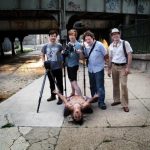Con Edison Immigrant Artist Program Newsletter, Issue No. 44
Featured Organization: Casita Maria Center for Arts and Education
Casita Maria Center for Arts and Education was founded in 1934 to serve the immigrant Hispanic community in New York City. Its primary mission was to offer after school enrichment and recreational activities for the children of newly arrived families from Puerto Rico and other Spanish-speaking countries. As more Hispanic families came to New York City, however, the need for additional services grew. Throughout the 1970’s Casita Maria expanded their programs to include homeless services, drug rehabilitation, violence prevention, gang intervention, teen pregnancy prevention,and many others. Today, it is one of the few organizations in the South Bronx that welcomes young children and offers services to them until college, while also providing family learning through the arts.
Casita Maria opened a new building in 2009 and has seen dramatic changes in its programming since then. It’s increased the number of students served from 200 to more than 1,300 and launched a major gallery and performing arts program that attracts an adult audience of over 8,000. Casita Maria has developed partnerships with more than 40 schools around the city and partners with many other cultural organizations, including Carnegie Hall, Alliance for Young Artists and Writers, The Point, and Dancing in the Streets. The organization also works with a wide range of city agencies and has collaborated with many peer education organizations. NYFA Program Associate Michon Ashmore interviewed Casita Maria about the organization’s programs, its place in the local community, and an exciting new initiative that’s underway.
Your partnerships with schools and other organizations are an essential element of your capacity to serve students and the community. How did this collaborative process evolve and how do these partnerships enhance the services you provide?
Each partnership is different. With schools we have a formal relationship that is carefully designed to ensure that the work we do supports the outcomes they want for their students. With other cultural organizations we make sure to have open, transparent conversations in a timely manner so that everyone is always on the same page. We tend to partner with organizations that are similar in their ultimate goals, but with different missions and programs. We want our partners to provide the expertise we do not have and vice versa. Each partnership provides additional access to experiences, programs, talent and opportunities for the constituents we serve.
You partner with Residency Unlimited to provide a residency for international artists. What is the goal of the residency? What do you look for when you’re considering artists who have applied for it?
Actually, we work with both local and international artists in this program. Our aim is to identify artists with strong connections to the idea of community and give them space to develop their work; we seek out artists who are passionate about community involvement and bring them to the South Bronx where they will engage with our neighbors to explore their history and creativity. Nominally, the project is a residency. But it is an exceptional residency, one that focuses on the creativity and potential that surrounds the artist and invites them to respond to it.
In addition to arts education, Casita Maria also incorporates performing, literary and visual arts into its programming. Why was it important to focus on all of these areas of art? What has the community’s response been to the cultural events you provide?
We care passionately about all the arts, and we believe that our community should have access to the highest quality creative work. So, for us, exemplary artistic practice means ensuring that everyone from our community can enjoy and participate in the finest artistic productions. Since the opening of the new building we have seen our audiences and the numbers of community members engaged in arts based projects consistently grow.
What new initiatives are you working on?
The South Bronx Culture Trail, which we are developing with our Company in Residence, Dancing in the Streets, is perhaps our major cultural project at the moment. The project began with the recognition that the cultural history of the South Bronx—Salsa and Hip-Hop were born here—is at risk of being lost: performers have left the area; clubs and theaters have closed; memories and opportunities for recovery are passing. Through the Trail—which includes physical markers, public performances and installations, exhibitions, a commissioning program, real world learning opportunities for community youth, city-wide outreach, guided and self-guided tours, and a website—we will reclaim and celebrate this history, offer a motor for local economic development and cultural tourism, and create opportunities for the area’s youth and families to directly participate in the City’s cultural economy.
How can artists get involved with Casita Maria? Are there any residencies or exhibition opportunities they can apply to?
The best way to get involved is to sign up for our e-mail notifications at http://www.casita.us/. That way you will be sure to receive information about all of our programs. The two projects that artists can directly apply to are:
- The Artist in Residence program for which we issue an RFP at least twice each year. Details of this can also be found on the Residency Unlimited website.
- South Bronx Performers Residency. This program will offer five Bronx-based performers or performance groups access to rehearsal space at Casita Maria; a $1,000 stipend; and marketing, public relations and technical support. [email protected] for more information about this residency.
IAP would like to thank Michon Ashmore, Digital Advertising Program Associate, for her contribution to this interview.




